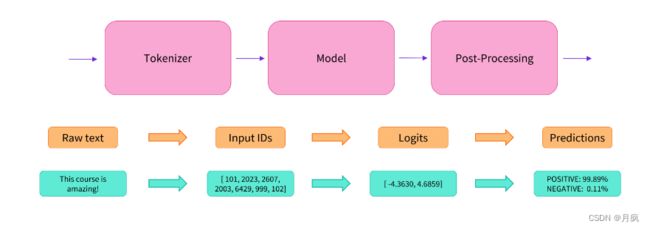Pipeline是如何运行
pipeline 的两个重要组件模型(
Models类)和分词器(Tokenizers类)的参数以及使用方式。
以第一个情感分析 pipeline 为例,我们运行下面的代码
from transformers import pipeline
classifier = pipeline("sentiment-analysis")
result = classifier("I've been waiting for a HuggingFace course my whole life.")
print(result)[{'label': 'POSITIVE', 'score': 0.9598048329353333}]
实际上它的背后经过了三个步骤:
- 预处理 (preprocessing),将原始文本转换为模型可以接受的输入格式;
- 将处理好的输入送入模型;
- 对模型的输出进行后处理 (postprocessing),将其转换为人类方便阅读的格式。
使用分词器进行预处理
因为神经网络模型无法直接处理文本,因此首先需要通过预处理环节将文本转换为模型可以理解的数字。具体地,我们会使用每个模型对应的分词器 (tokenizer) 来进行:
- 将输入切分为词语、子词或者符号(例如标点符号),统称为 tokens;
- 根据模型的词表将每个 token 映射到对应的 token 编号(就是一个数字);
- 根据模型的需要,添加一些额外的输入。
我们对输入文本的预处理需要与模型自身预训练时的操作完全一致,只有这样模型才可以正常地工作。注意,每个模型都有特定的预处理操作,如果对要使用的模型不熟悉,可以通过 Model Hub 查询。这里我们使用 AutoTokenizer 类和它的 from_pretrained() 函数,它可以自动根据模型 checkpoint 名称来获取对应的分词器。
情感分析 pipeline 的默认 checkpoint 是 distilbert-base-uncased-finetuned-sst-2-english,下面我们手工下载并调用其分词器:
from transformers import AutoTokenizer
checkpoint = "distilbert-base-uncased-finetuned-sst-2-english"
tokenizer = AutoTokenizer.from_pretrained(checkpoint)
raw_inputs = [
"I've been waiting for a HuggingFace course my whole life.",
"I hate this so much!",
]
inputs = tokenizer(raw_inputs, padding=True, truncation=True, return_tensors="pt")
print(inputs)结果:
{
'input_ids': tensor([
[ 101, 1045, 1005, 2310, 2042, 3403, 2005, 1037, 17662, 12172, 2607, 2026, 2878, 2166, 1012, 102],
[ 101, 1045, 5223, 2023, 2061, 2172, 999, 102, 0, 0,
0, 0, 0, 0, 0, 0]
]),
'attention_mask': tensor([
[1, 1, 1, 1, 1, 1, 1, 1, 1, 1, 1, 1, 1, 1, 1, 1],
[1, 1, 1, 1, 1, 1, 1, 1, 0, 0, 0, 0, 0, 0, 0, 0]
])
}可以看到,输出中包含两个键
input_ids和attention_mask,其中input_ids对应分词之后的 tokens 映射到的数字编号列表,而attention_mask则是用来标记哪些 tokens 是被填充的(这里“1”表示是原文,“0”表示是填充字符)。raw_input:输入
padding=True:表示padding填充
truncation=true:表示超过了最大长度的文本,直接截取
return_tensors='pe' 表示返回pytorch可以接受的tensor,tf表示返回tensorflow介意接受的tensor,如果返回np表示Numpy arrays
将预处理好的输入送入模型
预训练模型的下载方式和分词器 (tokenizer) 类似,Transformers 包提供了一个 AutoModel 类和对应的 from_pretrained() 函数。下面我们手工下载这个 distilbert-base 模型:
from transformers import AutoModel
checkpoint = "distilbert-base-uncased-finetuned-sst-2-english"
model = AutoModel.from_pretrained(checkpoint)预训练模型的本体只包含基础的 Transformer 模块,对于给定的输入,它会输出一些神经元的值,称为 hidden states 或者特征 (features)。对于 NLP 模型来说,可以理解为是文本的高维语义表示。这些 hidden states 通常会被输入到其他的模型部分(称为 head),以完成特定的任务,例如送入到分类头中完成文本分类任务。
其实前面我们举例的所有 pipelines 都具有类似的模型结构,只是模型的最后一部分会使用不同的 head 以完成对应的任务。
Transformers 库封装了很多不同的结构,常见的有:
*Model(返回 hidden states)*ForCausalLM(用于条件语言模型)*ForMaskedLM(用于遮盖语言模型)*ForMultipleChoice(用于多选任务)*ForQuestionAnswering(用于自动问答任务)*ForSequenceClassification(用于文本分类任务)*ForTokenClassification(用于 token 分类任务,例如 NER)
Transformer 模块的输出是一个维度为 (Batch size, Sequence length, Hidden size) 的三维张量,其中 Batch size 表示每次输入的样本(文本序列)数量,即每次输入多少个句子,上例中为 2;Sequence length 表示文本序列的长度,即每个句子被分为多少个 token,上例中为 16;Hidden size 表示每一个 token 经过模型编码后的输出向量(语义表示)的维度。
预训练模型编码后的输出向量的维度通常都很大,例如 Bert 模型 base 版本的输出为 768 维,一些大模型的输出维度为 3072 甚至更高。
我们可以打印出这里使用的 distilbert-base 模型的输出维度:
from transformers import AutoTokenizer, AutoModel
checkpoint = "distilbert-base-uncased-finetuned-sst-2-english"
tokenizer = AutoTokenizer.from_pretrained(checkpoint)
model = AutoModel.from_pretrained(checkpoint)
raw_inputs = [
"I've been waiting for a HuggingFace course my whole life.",
"I hate this so much!",
]
inputs = tokenizer(raw_inputs, padding=True, truncation=True, return_tensors="pt")
outputs = model(**inputs)
print(outputs.last_hidden_state.shape)
torch.Size([2, 16, 768])
Transformers 模型的输出格式类似 namedtuple 或字典,可以像上面那样通过属性访问,也可以通过键(outputs["last_hidden_state"]),甚至索引访问(outputs[0])。
对于情感分析任务,很明显我们最后需要使用的是一个文本分类 head。因此,实际上我们不会使用 AutoModel 类,而是使用 AutoModelForSequenceClassification:
from transformers import AutoTokenizer
from transformers import AutoModelForSequenceClassification
checkpoint = "distilbert-base-uncased-finetuned-sst-2-english"
tokenizer = AutoTokenizer.from_pretrained(checkpoint)
model = AutoModelForSequenceClassification.from_pretrained(checkpoint)
raw_inputs = [
"I've been waiting for a HuggingFace course my whole life.",
"I hate this so much!",
]
inputs = tokenizer(raw_inputs, padding=True, truncation=True, return_tensors="pt")
outputs = model(**inputs)
print(outputs.logits.shape)
torch.Size([2, 2])
可以看到,对于 batch 中的每一个样本,模型都会输出一个两维的向量(每一维对应一个标签,positive 或 negative)。
对模型输出进行后处理
由于模型的输出只是一些数值,因此并不适合人类阅读。例如我们打印出上面例子的输出:
from transformers import AutoTokenizer
from transformers import AutoModelForSequenceClassification
checkpoint = "distilbert-base-uncased-finetuned-sst-2-english"
tokenizer = AutoTokenizer.from_pretrained(checkpoint)
model = AutoModelForSequenceClassification.from_pretrained(checkpoint)
raw_inputs = [
"I've been waiting for a HuggingFace course my whole life.",
"I hate this so much!",
]
inputs = tokenizer(raw_inputs, padding=True, truncation=True, return_tensors="pt")
outputs = model(**inputs)
print(outputs.logits)
tensor([[-1.5607, 1.6123], [ 4.1692, -3.3464]], grad_fn=)
模型对第一个句子输出 $[-1.5607, 1.6123]$,对第二个句子输出 $[ 4.1692, -3.3464]$,它们并不是概率值,而是模型最后一层输出的 logits 值。要将他们转换为概率值,还需要让它们经过一个 SoftMax 层,例如:
import torch
predictions = torch.nn.functional.softmax(outputs.logits, dim=-1)
print(predictions)
tensor([[4.0195e-02, 9.5980e-01], [9.9946e-01, 5.4418e-04]], grad_fn=)
所有 Transformers 模型都会输出 logits 值,因为训练时的损失函数通常会自动结合激活函数(例如 SoftMax)与实际的损失函数(例如交叉熵 cross entropy)。
这样模型的预测结果就是容易理解的概率值:第一个句子 $[0.0402, 0.9598]$,第二个句子 $[0.9995, 0.0005]$。最后,为了得到对应的标签,可以读取模型 config 中提供的 id2label 属性:
print(model.config.id2label){0: 'NEGATIVE', 1: 'POSITIVE'}
于是我们可以得到最终的预测结果:
- 第一个句子: NEGATIVE: 0.0402, POSITIVE: 0.9598
- 第二个句子: NEGATIVE: 0.9995, POSITIVE: 0.0005

